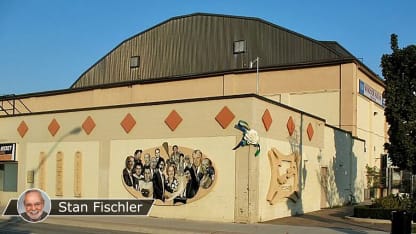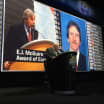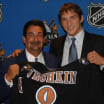Legendary hockey reporter Stan Fischler writes a weekly scrapbook for NHL.com. Fischler, known as "The Hockey Maven," shares his humor and insight with readers each Wednesday.
This week Fischler takes us back to the late 1920s during the National Hockey League's first major expansion. Although new franchises had been awarded to Detroit and Chicago, their respective new arenas had not been completed in time. Hence, they played their "home" games away from home.
Chicago, Detroit expansion teams played 1926-27 'home' games in Canada
Black Hawks, Cougars struggled in standings until new arenas were built

By
Stan Fischler
Special to NHL.com
Neither Fort Erie nor Windsor, Ontario ever figured to be permanent homes for an NHL franchise in the late 1920's. And the same held for Chicago's Coliseum. The rinks were either too small or -- as in the case of the Coliseum -- too dilapidated for permanent NHL use.
But both new expansion teams -- the Chicago Black Hawks and Detroit Cougars -- had built their roster and were scheduled to play in the 1926-27 season.
With Detroit's palatial Olympia still under construction and Chicago's enormous Stadium even further behind its target date for completion, something had to be done to accommodate the expansion franchises.
The other NHL expansion team, the New York Rangers, had a home in the one-year-old Madison Square Garden, which already housed its original hockey tenant, the New York Americans.
Without a suitable building, Detroit didn't have to look very far for a temporary home. Just across the river, on the Ontario side, the city of Windsor had built Border Cities Arena that opened the same year as The Garden in New York. It originally was supposed to hold 6,000 seats, but 3,000 more were installed for the Cougars home games.
Their makeshift home ice hardly was an advantage for the displaced Cougars. They finished their 44-game season at the bottom of the American Division. But in 1927-28, the Cougars had their own new, cavernous arena -- Olympia Stadium -- with 15,000 seats on the corner of Grand River and McGraw.
Detroit's eager hockey crowd welcomed the new franchise on Nov. 27, 1927, although the visiting Ottawa Senators defeated the home club 2-1. Still, the spanking new home proved to be a tonic for the team. The Cougars finished at the .500 mark (19-19-6) for 44 points, a leap of 16 points over its inaugural season.
The Black Hawks launched their opening campaign at the 6,000-seat Chicago Coliseum on Nov. 17, 1926. The Black Hawks won the opener 4-1 against the Toronto Maple Leafs and, for all intents and purposes, the Coliseum was as reasonable a home as the new club could expect. As for expectations about the planned Chicago Stadium, they proved disappointing.
Delays of various kinds kept setting back the new arena's opening. Even the Coliseum had to displace the Black Hawks when it had other fixed dates such as the circus or political rallies. In those instances alternates had to be found. One was a temporary haven at Detroit's Olympia. Another was Fort Erie, Ontario, conveniently located opposite Buffalo, New York.
Since Chicago Stadium still was unfinished well into the 1928-29 season, an unusual welcome was extended by Fort Erie's Peace Bridge Arena which was only a few months old.
Apart from being state of the art for its time, the Peace Bridge facility had a major advantage being so close to hockey-mad Buffalo.
"We're only 10 minutes from (Buffalo's) Shelton Square" boasted one of the arena's newspaper ads.
The Black Hawks played the first of three straight Fort Erie games on Feb. 9, 1929, against the Americans. Although the arena's capacity was listed at 5,000, a capacity crowd of 6,500 showed up.
The 1-0 final score was less significant than the event itself. The Buffalo Courier-Express hailed the enthusiastic turnout with a headline that suggested that an NHL team might be in Buffalo's future:
"BUFFALO'S ABILITY TO SUPPORT MAJOR LEAGUE HOCKEY IS PROVEN BY BIG ATTENDANCE AT PEACE BRIDGE ARENA."
The newspaper's story led off as follows: "Major league hockey for Buffalo does not appear so far off now after a capacity crowd of 6,500 persons jammed every inch of space in the Peace Bridge Arena." The reporter described the Black Hawks as "homeless waifs of the National League."
Most significant was the excitement inspired by the contest. Pregame ads referred to hockey as the "Fastest Game In The World." As for big-league hockey's future in the area, the Courier-Express correspondent put it this way:
"It is not impossible that next fall will see a major league sextet sporting the banner of Buffalo. Anyway, if such is not the case next fall, it will not be long thereafter before Buffalo is in the major league class."
Two more games were played in Fort Erie. On Feb. 14, 1929, Chicago hosted the Montreal Canadiens and two nights later, the Boston Bruins invaded Peace Bridge Arena.
According to Jack Laing, who covered the Bruins-Black Hawks game for the Buffalo Courier-Express, he witnessed one of the most unusual saves ever made by an NHL goalie. (This, by the way, was during the era when goalies had to serve their own penalties.)
Chicago's Chuck Gardiner was in the penalty box when Bruins defenseman George Owen snared the puck inside the Black Hawks blue line. Just then, Gardiner bolted from the penalty box.
"Owen took careful aim with a long shot, and Gardiner, racing over the ice in his cumbersome pads, leaped into the air like an agile shortstop and caught the puck halfway to the net!," Laing wrote.
Chicago Stadium finally opened on March 28, 1929, the largest arena of its kind in the world at that time. And as far as the Black Hawks were concerned it was to be a welcome home. As nomads during the 1928-29 season they finished last in the American Division. Their record was a dismal 7-29-8 (22 points).
A season later -- with crowds that exceeded 17,000 at the spanking new Stadium -- the Black Hawks climbed to second place (21-18-5). Their 47 points were 25 more than the previous season.
By that time, the American NHL cities -- New York, Chicago, Detroit and Boston -- each had modern arenas with a larger seating capacity than any NHL rink in Canada. But the delayed opening of Chicago's Stadium proved an inspiration for Conn Smythe whose Maple Leafs had been burdened by their smallish Mutual Street Arena that could hold no more than 7,500 fans including standing room.
On Jan. 17, 1931, Toronto's hockey boss declared "We have decided to go ahead with construction of a modern arena which will be suitable for hockey and all other sports."
Construction began on June 1, 1931, and was completed in time for the 1931-32 season. On April 9, 1932 a crowd of 14,366 watched the Maple Leafs win their first Stanley Cup.
If nothing else the victory proved something that both fans in Detroit and Chicago already had learned: that there's something to be said for the old bromide, "Home is where the heart is."
And, in Toronto's case, the Stanley Cup!

















